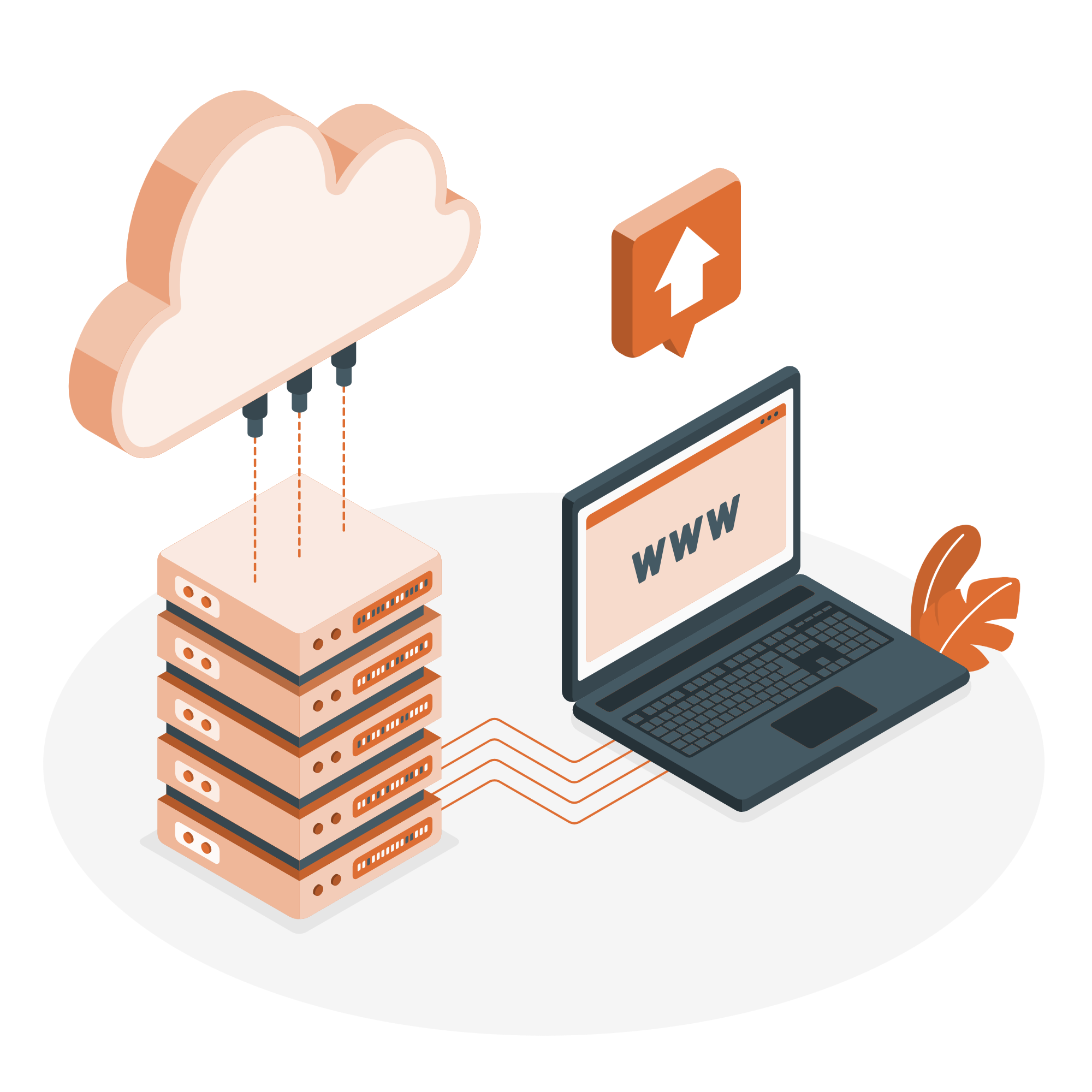Cloud – The Final Frontier for Education Tech

From the time when well-maintained computer systems were considered the final frontier to today when we are talking about cloud, technology has come a long way.
So do the education institutes.
Remember how we used to wait for days to know when the final cut-offs for our dream college would be out and then stand in long lines to get the application form? To today, when we can explore the cut-offs of every institute and fill out the forms in a few clicks from the comfort of our homes.
Every fabric of tech and education has undergone ‘evolution’.
The term “evolution” embodies the power to change the world for a better future. And the evolution of cloud computing embodies the power to change the classic operations of education institutes for the better.
Instead of just accepting the cloud as the frontier we will explore its different elements and significance.
The Evolution of Cloud Computing: Classic Tech

What is cloud computing:
As per Wikipedia Cloud computing is the on-demand availability of computer system resources, especially data storage (cloud storage) and computing power, without direct active management by the user. Large clouds often have functions distributed over multiple locations, each of which is a data centre. Cloud computing relies on sharing of resources to achieve coherence and typically uses a pay-as-you-go model, which can help in reducing capital expenses but may also lead to unexpected operating expenses for users.
There are 5 essential characteristics for a service to be called cloud. On-demand self-service, Broad network access, Resource pooling, Rapid elasticity, Measured service.
The Story of Evolution:
It all began during the 1950s and 1960s when the world was making pace with the Cuban Revolution and celebrating space explorations. A few technical geniuses were developing powerful computers that were accessed by multiple users through dumb terminals.
These systems were to be known as mainframe computing, or, an early form of centralized computing that laid the foundation for remote data processing and shared access.
From here an era of drastic technological revolution begins:
|
Client-Server Model (1980s and 1990s) |
|
Internet and Web Hosting (1990s) |
|
Utility Computing (the early 2000s) |
|
Grid Computing (early-2000s) (A virtual supercomputer to leverage collective processing power for complex tasks) |
|
Virtualization (mid-2000s) |
Virtualization sets the stage for cloud computing. It enables the efficient partitioning of computing resources and conceptualization of infrastructure.
Birth of Modern Cloud Computing
|
Infrastructure as a Service (IaaS) |
|
Platform as a Service (PaaS) |
|
Software as a Service (SaaS) |
|
Function as a Service (FaaS) |
Booming Cloud Computing: Modern Edu-Tech Tale

The 2000s are an era of technological advancement. Right from the launch of Facebook and the iPhone to the rise of blended learning and global collaboration. Technology and education have independently undergone some notable advancements, and cloud computing acts as a catalyst in the process.
Today, you are seeing the magic of cloud computing everywhere and every day, just like Netflix.
Ahh! This reminds me that even Netflix gained prominence by leveraging cloud computing. The platform optimizes the cost of building and maintaining infrastructure, utilizes the cloud to distribute content globally, and focuses on quality content with reduced time-to-market. And the results are extraordinarily profitable.
Amazing right?
Prepare to be even more amazed by the fact that the leading educational institutes have not only adopted this model but have also begun reaping substantial profits from it.
Tech-Amazements in Education Institutes Check ✔️
Georgia Institute of Technology
Georgia Tech has successfully implemented cloud computing technologies in its educational programs. They offer a fully online Master’s degree in Computer Science (OMS CS) program, known as the “Georgia Tech Online Master of Science in Computer Science,” delivered via the cloud-based platform Udacity. The program has been highly successful, attracting thousands of students globally and generating substantial revenue for the institution.
Massachusetts Institute of Technology (MIT)
MIT has been at the forefront of exploring cloud computing for educational purposes. They have collaborated with Amazon Web Services (AWS) to offer a range of cloud computing courses, providing hands-on experience with cloud platforms and technologies. MIT also uses cloud-based tools for data storage, research collaboration, and running computational experiments.
Indian School of Business (ISB)
The ISB, a leading business school in India, has incorporated cloud computing into its operations. They utilize cloud-based learning management systems (LMS) to deliver online courses and programs. Additionally, ISB has implemented cloud infrastructure for storage, data analytics, and collaboration among students and faculty.
UniHawk Global Education Consultant
UniHawk, a leading study abroad consultancy, has successfully onboarded a cloud-based CRM and application module to streamline its entire lead management and application processes. They made sure that their valuable time and efforts were not spent on mundane management tasks and that they could focus more on strategies for their revenue growth and expansion.
As we marvel at these tech amazements, it’s vital to recognize the software that has been successfully scaled and adopted by educational institutes.
Top 5 Software Adopted by Education Industry
| Software | Function | Adoption Rate* |
| Enterprise Resource Planning (ERP) | Streamlines administrative processes manages student data and optimizes resource utilization | 60% |
| Customer Relationship Management (CRM) | Manages student admissions, enhances communication, and supports student engagement | 50% |
| Learning Management System (LMS) | Facilitates online course delivery, content management, student tracking, and collaboration | 40% |
| Content Management System (CMS) | Organizes and shares educational resources, documents, and multimedia content | 30% |
| Assessment | Facilitates online exams, quizzes, and evaluations | 20% |
*The data has been provided by the ExtraaEdge Research team, backed by various vendor, website, and customer surveys.
Institutes have been adopting ERP, CRM, and LMS systems with relative ease, finding value in their functionalities. However, there seems to be some hesitation when it comes to CMS and Assessment systems. If you’re curious about the reasons behind this hesitation and would like a comprehensive understanding, we encourage you to reach out to us. We’ll provide you with an insightful answer that delves into the specifics of these reservations.
Why Cloud Computing and not On-premise?

After reading about some of these leading institutes and scaling software, one question is evidently hovering in your mind: what’s stopping them from building a system on their own software and opting for on-premise computing?
No paragraphs to answer this question, but just a comprehensive comparison.
| Point of Comparison | On-Premise | Cloud Computing |
| Building Infrastructure | Setting up required hardware such as servers, storage devices, and networking equipment, everything available on site. | Your cloud provider has set up everything for you. Maybe something more than required. |
| Cost | Significant upfront investment in hardware, software licenses, and infrastructure setup. The ongoing cost of maintenance, IT staff, and upgrades. | A pay-as-you-go model is available, allowing you to scale resources and pay only for what you use. This results in potential cost savings. |
| Scalability and Flexibility | Scalability and flexibility come at a very high upfront cost. | Additional computing resources can be easily provisioned or de-provisioned in the cloud, providing agility and elasticity. This can be a great saving when the institutes have holidays and do not require computing resources |
| Upgrades and Maintenance | You are solely responsible for upgrading and maintaining hardware, software, and infrastructure. | Your cloud provider relieves you from all these time-consuming tasks. |
| Security & Compliance | Direct control over data while investing in robust security measures such as firewalls, and physical security. | Advanced security measures and compliance with industry standards and regulations. |
| Accessibility | Enables remote access to applications and data from anywhere with an internet connection. | Limitations on remote access unless additional infrastructure and VPN setups are implemented. |
| Disaster Recovery | You need to implement your own disaster recovery plans and invest in redundant systems for backup and data replication. | Built-in disaster recovery and backup capabilities, with data replication across multiple data centres. |
| Ability to Experiment and Undo | Since on-premise requires upfront commitments and investment. Changes cannot be done once the decisions are taken. You need to guess the future and plan for the capacity. Most of them get it wrong. | In the cloud, you can afford to experiment and fail fast. Since you have the ability to make the changes as and when required. As you do not have the burden to plan for the future. Decision-making becomes more simple. |
| Time | The time to procure and install the hardware can range from 2-6 weeks. | In the cloud, you can get up and running in minutes. |
| AI /ML | Training AI/ML models require specific hardware. Making huge investments in such hardware is challenging particularly when we do not have the requirements all year long. | AI/ML the main philosophy is not to reinvent the wheel. The cloud lets you use pre-trained models, Auto ML and Hardware designed for training custom models on the Pay as you Go model |
We hope you have now gotten your answer. But the loop of questions never stops here; the next question popping into your mind will be how to choose the right cloud service provider for your institute.
To answer the same, we have our subject-matter expert, Mr Abdul Muneem, the co-founder at Brio Technologies, a leader in the cloud space with a 15-year of rock-solid experience in the cloud.
How to choose the right Cloud Service Provider for your Education Institute?

Choices are a great thing to have. But making the right choice is important. Let’s look at the factors you need to consider when making the choice of which cloud to move. It’s very important to assess the capabilities and reliability of the cloud service provider to whom you plan to entrust your organisation’s data and applications. A few things to look out for are
Business health and reputation: Financial stability is a key factor. It’s important for the cloud service provider to have financial stability to see if they can continue to do business in the long term but also make significant capital investments in the future.
Technical capabilities, roadmap and processes: Make sure the cloud service provider is at the forefront of services that are being offered in the market. It’s very important that the cloud service provider has the right people who can drive innovation, the right partnerships and the financial muscle to do things at scale.
Contracts, Commercials & SLAs: Commercials and contracts may differ from one cloud service provider to another. Review the commercials and contracts that best suit your business needs.
Security: We plan to entrust the cloud service provider with our data and applications. It is of paramount importance for the cloud service provider to maintain very high standards of security at all levels and types. This includes both physical and software security.
Reliability & Performance: It’s a common practice for the cloud service provider to publish the SLAs achieved by them. Please look for the SLAs the cloud service provider was able to achieve during the last 6 months. Downtimes are inevitable but it is the ability of the cloud service provider how they handle them.
Vendor Lock-in & Exit Planning: Ideally it should be as easy to get out of a cloud service provider as it is to get started with them. Make sure you have the right understanding of the exit terms when getting started and make as little use of proprietary technology and services offered by the cloud service provider.
Specific Programs for Educational Institutes: Please also check if your institute is eligible for any specific programs offered by the Cloud service provider to subsidise the cloud spend.
If you plan to use any of the hyperscalers AWS, Microsoft Azure or Google Cloud you can rest assured the above factors are addressed very well with these major cloud service providers. If you still feel overwhelmed by the process of choosing the right cloud service provider a good partner can really make this whole process simple, easy and successful for you.
Where do you stand?

We already have enough cloud talk; now it’s time to double-click on where you stand in terms of technological advancement.
Below is the checklist of cloud-based systems or services you should have adopted by now (at the bare minimum):
- Customer Relationship Management (CRM): A cloud-based CRM to streamline your admissions process by managing, nurturing and tracking each of your leads and converting more students.
- Assessment: Cloud-based assessment system to facilitate online entrance tests, quizzes, and examinations.
- Content Management System: A cloud-based CMS allows you to store, organize, and share educational resources, documents, and multimedia content. Easy access to content for students and educators.
- Learning Management System (LMS): An LMS is a fundamental cloud-based platform that enables online course delivery, content management, student tracking, and collaboration.
- Analytics and Reporting: A Cloud-based analytics tool is much needed to track progress, identify areas for improvement, and make data-driven decisions.
If you can check at least-
- 2 out of these 5 boxes, then you are starting to pave the way for technical advancement.
- 3 out of these 5, then you are igniting the fuel to stay on track.
- 4 out of these 5, then you are steadily gaining momentum in the race.
- 5 out of these 5, then we are eagerly awaiting your arrival at the winner’s coast, where success awaits.
Score 5/5 with ExtraaEdge Powered by Brio
We have now reached the final section of this article, where our goal is not only to leave you feeling knowledgeable and inspired but also empowered to reach new heights. By now, you should have a clear understanding of the significance of cloud computing and why it is crucial to incorporate it into your current education tech system(s).
If you already have a cloud-based system in place, congratulations! You have taken a crucial step towards ensuring the security and efficiency of your operations. Now, it’s time to score 5/5 by exploring ExtraaEdge.
ExtraaEdge is an all-in-one platform designed to streamline the admissions process. Trusted by more than 350 education brands, including prestigious institutions like BITS Pilani, Dubai, Manchester Metropolitan University, Brits Imperial Dubai, and many more across the globe, our suite of products is tailored to meet your unique requirements. From an education-focused CRM to robust Marketing Automation, complete with comprehensive reporting and analytics, we offer everything you need to enhance your admissions workflow.
The best part?
“Our products are already hosted on the cloud, thanks to our partnership with Brio Technologies!”
If, however, you haven’t yet made the switch to the cloud, don’t delay any further.
Consult with Brio Technologies, the leading cloud provider, to ensure a smooth transition. Brio specializes in streamlining business functions through cloud computing. Their team of highly skilled professionals, backed by wide-ranging industry expertise, is available to guide you every step of the way. As partners of Google, Microsoft, and AWS Cloud, Brio’s certified specialists work tirelessly to deliver optimal solutions to their customers. With Brio’s expertise, your institute can keep up with technological advancements and optimize your cloud costs.
The insights shared by Mr Abdul Muneem, our esteemed expert, are akin to a sumptuous plate of biryani, crafted and served exclusively for you. It’s up to you to decide whether you want it served warm and perfectly spiced or cold and lacklustre. Either way, your hunger for substantial growth will be satisfied.


